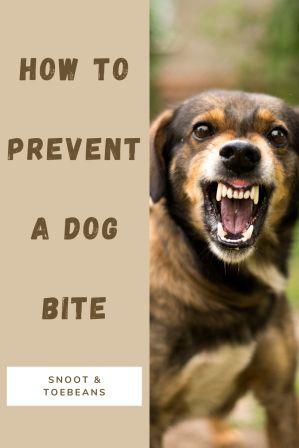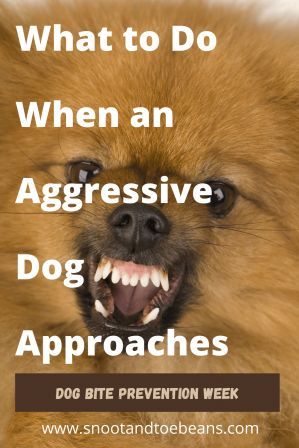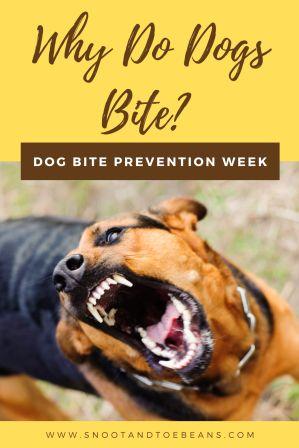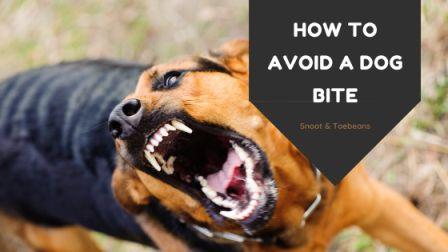Disclosure: My dog blog is supported by dog parents just like you. I only recommend products that I would use on my dogs. All opinions expressed here are my own. I sometimes earn a small affiliate commission, at no extra cost to you, when you click through the affiliate link and purchase something. You can read more about my affiliate policy here.

Have you educated your children or yourself on dog bite prevention before interacting with a dog? Or, as a dog parent, have you taken precautionary steps to help ensure your doggo doesn’t bite?
You can get informed on these two things during National Dog Bite Prevention Week. This week is nationally recognized during the second full week of April.
Most importantly, you need to understand that ANY dog can bite. It doesn’t matter how big or small, male or female, young or old. In addition, the most cuddliest, furriest, sweetest dog CAN bite. Furthermore, it’s not a certain dog breed either.
Consequently, whether a dog bites or not is determined by individual history and behavior. Plus, provoking a dog can cause him or her to bite.
Firstly, let’s look at some dog bite facts, before delving into dog bite prevention.
Dog Bite Facts

An estimated 4.5 million Americans are attacked annually, according to the Centers for Disease Control and Prevention, (CDC). And, over half of the victims bitten by dogs are children in the five to nine age groups. Secondly, are the elderly, and thirdly are Postal Service carriers to fall victim of a dog bite.
Although it’s not something the media covers every day, some dog bites are severe and life threatening. In fact, one in five dog bites become infected and require medical attention. Therefore, laws have been enacted to regulate dog ownership and even types of pets in homes.
Remember earlier I said ANY dog can bite. As a result, most children bitten are from everyday activities interacting with familiar dogs.
So, Why Do Dogs Bite?
Dogs can bite for any number of reasons, however the most common is a reaction to something.
For example, a reaction to:
- defending himself or herself; or their territory
- being scared or startled
- feeling threatened
- protecting something of value, such as, their puppies, their food, or a toy
- not feeling well, as a result of being sick or sore due to injury
- rough play
Certainly, there is good news though, and that is the majority of dog bites can be prevented. For instance, there are two main dog bite prevention methods. Firstly, being a responsible dog parent and secondly, practicing safe behavior around dogs.
Dog Bite Prevention as a Parent of Four-Legged Children
Some of the joy of being a parent to furry kids and snotty nosed kids is teaching good manners. Parents of one or the other, or both, need to properly care for, train and handle their children.
Plus, it’s impossible to guarantee that your dog will never bite someone. On the other hand, it’s impossible to guarantee that your child will never provoke a dog into aggression.
However, there are some do’s and don’ts you can take to help prevent your dog from biting.
Do:
- make your dog a part of the family
- when you are with your dog outside a fenced area or on a walk, properly secure them to a leash
- make sure your dog is up to date on vaccinations, especially rabies
- socialize your dog at an early age to be comfortable around people and other animals
- keep your dog away from situations that are threatening or impose teasing
- teach your dog some basic commands, such as, ‘stay’, ‘no’, ‘sit’, and ‘come’ (youtube videos can help with this or you can attend a training class with your dog)
- neuter or spay your dog (spayed and neutered dogs are less likely to bite)
- be aware of your dog’s warning signs that he or she feels aggression (the signs can look like refusing to obey, growling, nipping, or unprovoked attacks on another animal)
- regularly exercise your dog
Don’t:
- let your dog roam the streets unsupervised
- encourage him or her to be aggressive or to attack (yes, this means during play, too)
- leave your dog alone with small children
- chain or tie him or her outside (a restrained dog can feel defenseless and can become more likely to bite)
- leave your dog unsupervised for long periods of time
Common Stress Triggers For Your Dog to Avoid When Possible
- approach of strangers or strange dogs
- people in uniforms, costumes, or unusual attire, such as hats
- unexpected touching
- unfamiliar places, crowds, and loud noises, such as thunder, wind, construction, fireworks, and appliances.
If your dog shows signs of stress in crowded areas, then leave him or her home. Moreover, your dog may overreact to visitors or delivery people, so keep him or her in another room. Meanwhile, you can work with professionals trained for behavior to help your dog become comfortable in stressful situations.
Dog Bite Prevention as an Adult and Parent of Two-Legged Children
All two-legged family members should have at least the minimum knowledge of dog bite prevention. Above all, because most victims are bitten by their family dog or a friend’s dog.
A good rule of thumb to follow as a parent is to always supervise your children when they are with dogs. Yes. Even the family dog. For instance, never leave a baby or a child younger than 10 years old alone with a dog.
In addition, teach a child how to treat a dog gently and with respect. Children can learn how to give a dog their own space and opportunities to rest.
People, especially children should be taught how to interact with dogs. And, it doesn’t matter if it is the family dog or a neighbor’s dog on a walk. Parents need to educate their children on what types of behavior might provoke a dog to bite.
Prevention to Avoid Provoking a Dog Bite

Don’t:
- directly take bones, balls, sticks, or other toys away from a dog
- bother a dog that is sleeping, eating, caring for puppies, sick, or injured
- enter an unknown dog’s yard or put your hand through a fence or car window to pet a dog
- approach a stray dog or dog roaming without a leash or owner nearby
- approach a barking, growling, or scared dog
- try petting a dog if the owner does not give you permission
There is a Right Way to Approach a New Dog
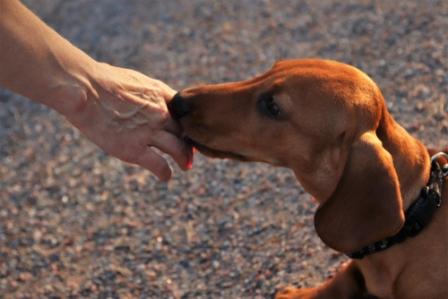
Most importantly, always ask an owner for permission to pet their dog. Then if permission is granted, do the following:
- Stand at a safe distance, but within reach of the dog.
- Slowly extend your arm, holding your hand palm down, about nose level.
- Let the dog approach you and let the dog sniff the top of your hand.
- If the dog remains tense, allow him or her to continue sniffing you.
- Once the dog relaxes, it is safe to pet them.
- However, avoid petting the dog on the top of the head. You can pet him or her on the shoulders or chest.
In addition, children especially, need to be taught how to properly play with dogs. They also need understanding of what to do when an unknown dog is roaming unleashed in the neighborhood. Therefore, if the dog is aggressive, they will be more likely to handle it.
Dog Confrontation Tips
- Never run away or back away from an unknown or confrontational dog approaching.
- Avoid eye contact with an unknown or confrontational dog. Lower your head and look down at your feet or the dog’s front paws.
- Remain calm when an unknown or confrontational dog approaches.
- Try talking to the dog to calm it down. You can firmly tell the dog that it is ‘okay’. In addition, try firmly saying ‘no’ or ‘down’ or ‘go home’.
Easy to Remember Dog Confrontation Tips For Children
- Be Like a Tree – stand still with your feet together and your fists under your chin with elbows into your chest. Let the dog sniff you, wait for the dog to leave, then slowly walk away.
- Act Like a Log – If you are already on the ground or the dog knocks you down, lay still, face down, legs together with fists covering the back of your neck and forearms over your ears. Again, let the dog sniff you, wait for the dog to leave, then slowly walk away.
What if the dog goes ahead and attacks your child? Teach your child to grab onto or anything to put between him or herself and the dog. These can include a jacket, a backpack, or a bicycle to give the dog an object besides them to bite.
The American Veterinary Medical Association encourages parents to share their Jimmy the Dog videos about dog bite prevention.
In Conclusion
Just like people, dogs can express themselves through body gestures, postures, and vocalizations when reacting to something. So, it is evident that dogs do communicate if they are stressed, frightened, or threatened. And, if we pay attention to it, we can avoid a dog bite.
But, in the instance that you or your child are bitten, there are a few things you should do. Firstly, teach children to tell an adult if they are bitten.
Next, use soap and water to clean the bite wound and immediately contact your family physician.
In addition, contact your local animal control, so they can safely apprehend the dog.
If the dog is unknown to you or your child, do your best to remember the:
- breed
- color
- size
- which direction the dog went
Have you had experience with a dog bite? Do you have more prevention methods you can share with us? We would love to hear about it in the comments below.
You might like these posts from the Snoot & Toebeans’ Dog Blog:
If you would like to save this post to your Pinterest account, you can use one of the following images.
